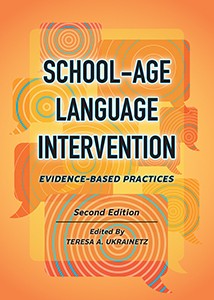*** DISCONTINUED (NO LONGER AVAILABLE) ***
School-Age Language Intervention: Evidence-based Practices explains how to teach the language and literacy skills, strategies, and underlying processes needed for educational success. This book brings together an array of experts to provide the latest practical and evidence-based guidance to school speech-language pathologists.
School-Age Language Intervention shows that the research evidence continues to support the themes of the popular Contextualized Language Intervention: intervention within naturalistic, motivating communicative contexts, using the critical treatment elements of RISE (Repeated opportunities, Intensive schedule, Systematic support, Explicit skill focus).
School-age Language Intervention is organized into three sections:
- Section 1: addresses the fundamentals of school SLP practice: who works on what; the ways treatment can be structured; and the “rules of the road” that govern special education and SLP services. This section explains evidence-based practice and helps students and clinicians make sense of the complicated world of research evidence. The best of skill-based and naturalistic intervention are combined in a RISE-based whole-part-whole framework. Academic standards, particularly the new Common Core State Standards, are used to link treatment to the classroom. This section ends with critical consideration of specific language impairment and reading disability that includes the latest brain research, and how second-language-learners fare in different instructional and treatment formats.
- Section 2: details best practices for spoken and written language intervention. Chapters address how to effectively teach diverse and deep vocabulary knowledge, complex syntactic skills, and the narrative and informational discourse needed to understand and produce academic texts. A chapter is devoted to helping children at environmental risk to cope with the expectations of school.
- Section 3: addresses the written code and the cognitive underpinnings of school success: phonological processing, word identification, reading fluency, and spelling. Language and print demands come together in a chapter addressing effective instruction for text comprehension. The book ends with “the final frontier” of supporting high school and college students who have reading difficulties.
- Copyright 2015

 Proud to be Canadian
Proud to be Canadian


